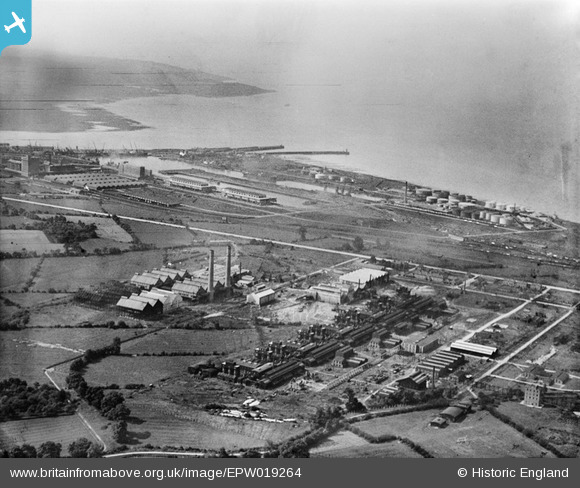 Superphosphate Plant process buildings. |

steve |
Thursday 19th of May 2016 09:58:11 AM |
 Superphosphate Plant Warehouse. |

steve |
Thursday 19th of May 2016 09:55:35 AM |
 Finished Product Storage.
This six bay structure may contain the horizontal acid storage tanks of the WW1 plant. Rail handling facilities would have been required, it is not clear from this photograph if railway track exists? What do you think dear viewer? |

steve |
Wednesday 11th of May 2016 11:08:38 AM |
 Absorption House.
Absorption House Equipment. Six absorption towers with quartz filling. Acid coolers. Acid circulation tanks and acid weighing system. Oleum tank and acid pumping equipment to finished products store etc. |

steve |
Wednesday 11th of May 2016 11:00:09 AM |
 SO3 coolers. |

steve |
Wednesday 11th of May 2016 10:34:08 AM |
 Converter House.
Each converter house contained two preheater units, four converter units and four heat exchanger units. The converters were of the regenerative type containing magnesium sulphate. The preheaters were coal fired. Located between the converter house and the burner house is the metal flue for the preheaters. This flue was also shared by the sulphur burners. The converter building is of a steel frame construction and clad with corrugated sheet which has been coated with a bitumen based paint. The converter house has a monitor roof which contained louvres to aid cooling and disperse fumes. The steel main carrying cold SO2 gas can be seen entering the converter house on the left-hand side. |

steve |
Monday 9th of May 2016 08:49:22 PM |
 Filter Building. |

steve |
Tuesday 3rd of May 2016 10:32:32 PM |
 Chimney.
Flue for converter house preheaters and sulphur burners. |

steve |
Tuesday 3rd of May 2016 10:16:49 PM |
 Scrubbing Tower.
The scrubbing towers are set in batteries of three per unit. Each tower is packed with coke. The structure on top of the battery is the tank room and below this the distributor room. The gas on leaving the two primary filters entered the bottom of the first tower passing up through the packing material to the top. Acid recovered from the gas percolated down through the coke to a cooler and then drained into a low level feed tank. The gas from the top of the first tower was fed down to the base of the second tower then rising to the top and likewise to the third tower. The gas then passed through the three final stage filters, which also contained coke packing. Thence to the pressure equalizer and blower unit / grease catcher / finally cold gas was fed to the heat exchanger in the converter house. |

steve |
Sunday 1st of May 2016 09:54:55 PM |
 Purification System.
Heater Cooler / Dust Catcher.
Burner Gas Cooler / SO2 Cooler.
Filters, pre and post Scrubbing / Drying Towers. |

steve |
Saturday 30th of April 2016 04:51:57 PM |
 Burner House and raw materials store.
In the Department of Explosive Supply configuration, each burner house contained twelve sulphur burners. This consisted of cast iron pans 2.184400 m x 1.066800 m and 0.1270000 m in depth and set side by side. The sulphur was fed into the pans by hand. The correct burn rate was achieved by regulating the air supply to the burners.
|

steve |
Sunday 24th of April 2016 10:19:13 PM |
 The National Smelting Company, Avonmouth.
Contact process for the manufacture of sulphuric acid.
The Avonmouth sulphuric acid plant was designed by the Department of Explosive Supply and erected in 1917 for the Ministry of Munitions by Robert McAlpine & Sons. The units were built in pairs, "left-hand" and "right-hand" and faced each other as in the case of the scrubbing towers,three towers per unit, or individual items of plant per unit placed adjacent to one another as in the converter houses.
The buildings are of steel frame construction and clad with corrugated sheeting. Brick, tile, lead and wood were used in the construction of the various items of plant. During the nineteen twenties the sulphur burning contact plant was modified to use zinc roaster gases from the Delplace roasters which was the original intention.
|

steve |
Sunday 24th of April 2016 06:54:00 PM |
 Port of Bristol Authority.
Shed "V".
"V" shed is of reinforced concrete construction and has three floors. Approximate dimensions are, length 500 feet, width 120 feet. The shed has band conveyors connecting it to the Transit Granary. The shed is a grain and general cargo store.
|

steve |
Saturday 19th of December 2015 02:32:33 AM |
 Delplace roasting plant. |

steve |
Saturday 19th of December 2015 01:54:24 AM |
 This industrial site was first used during the First World War when the government built a munitions plant, providing sulphuric acid for the manufacture of explosives and fertilisers. In 1917, the National Smelting Company built a zinc smelting plant next to the munitions factory. |

Lynda Tubbs |
Thursday 27th of February 2014 02:37:45 PM |
 Royal Edward Dock |

Class31 |
Saturday 22nd of February 2014 07:47:42 PM |
 St. Andrew's Road |

Class31 |
Monday 6th of August 2012 04:02:04 PM |


















![[EPW019264] The National Smelting Company Avonmouth Works and the Avonmouth Docks, Avonmouth, 1927](http://britainfromabove.org.uk/sites/all/libraries/aerofilms-images/public/100x100/EPW/019/EPW019264.jpg)
![[EAW049578] Imperial Smelting Corporation Works, Fisons Ltd Fertilizer Works and Avonmouth Docks, Avonmouth, 1953. This image was marked by Aerofilms Ltd for photo editing.](http://britainfromabove.org.uk/sites/all/libraries/aerofilms-images/public/100x100/EAW/049/EAW049578.jpg)
![[EPW005486] The Great Western Railway Yard and Battery Farm, Avonmouth, 1921](http://britainfromabove.org.uk/sites/all/libraries/aerofilms-images/public/100x100/EPW/005/EPW005486.jpg)
![[EAW045840] Royal Edward Dock Eastern Arm and the Fisons Ltd Fertilizer Works, Avonmouth, 1952. This image was marked by Aerofilms Ltd for photo editing.](http://britainfromabove.org.uk/sites/all/libraries/aerofilms-images/public/100x100/EAW/045/EAW045840.jpg)
![[EAW002251] The Port of Bristol Authority Royal Edward Docks, Avonmouth, from the north-east, 1946. This image has been produced from a print.](http://britainfromabove.org.uk/sites/all/libraries/aerofilms-images/public/100x100/EAW/002/EAW002251.jpg)
![[EPW005484] The Great Western Railway Yard and Battery Farm, Avonmouth, from the south-west, 1921](http://britainfromabove.org.uk/sites/all/libraries/aerofilms-images/public/100x100/EPW/005/EPW005484.jpg)
![[EAW045838] Fisons Ltd Fertilizer Works, Avonmouth, 1952. This image was marked by Aerofilms Ltd for photo editing.](http://britainfromabove.org.uk/sites/all/libraries/aerofilms-images/public/100x100/EAW/045/EAW045838.jpg)
![[EAW045839] Royal Edward Dock Eastern Arm and the Fisons Ltd Fertilizer Works, Avonmouth, 1952. This image was marked by Aerofilms Ltd for photo editing.](http://britainfromabove.org.uk/sites/all/libraries/aerofilms-images/public/100x100/EAW/045/EAW045839.jpg)
![[EAW002074] The Eastern Arm at Avonmouth Docks, Avonmouth, 1946. This image has been produced from a print.](http://britainfromabove.org.uk/sites/all/libraries/aerofilms-images/public/100x100/EAW/002/EAW002074.jpg)
![[EAW002245] The Port of Bristol Authority Royal Edward Docks, Avonmouth, 1946](http://britainfromabove.org.uk/sites/all/libraries/aerofilms-images/public/100x100/EAW/002/EAW002245.jpg)
![[EAW002252] The Port of Bristol Authority Royal Edward Docks, Avonmouth, 1946. This image has been produced from a print.](http://britainfromabove.org.uk/sites/all/libraries/aerofilms-images/public/100x100/EAW/002/EAW002252.jpg)
![[EAW045833] Fisons Ltd Fertilizer Works, Avonmouth, 1952. This image was marked by Aerofilms Ltd for photo editing.](http://britainfromabove.org.uk/sites/all/libraries/aerofilms-images/public/100x100/EAW/045/EAW045833.jpg)
![[EAW002244] The Port of Bristol Authority Royal Edward Docks, Avonmouth, 1946. This image has been produced from a print.](http://britainfromabove.org.uk/sites/all/libraries/aerofilms-images/public/100x100/EAW/002/EAW002244.jpg)
![[EAW049584] Imperial Smelting Corporation Works and Fisons Ltd Fertilizer Works, Avonmouth, from the north-west, 1953. This image was marked by Aerofilms Ltd for photo editing.](http://britainfromabove.org.uk/sites/all/libraries/aerofilms-images/public/100x100/EAW/049/EAW049584.jpg)
